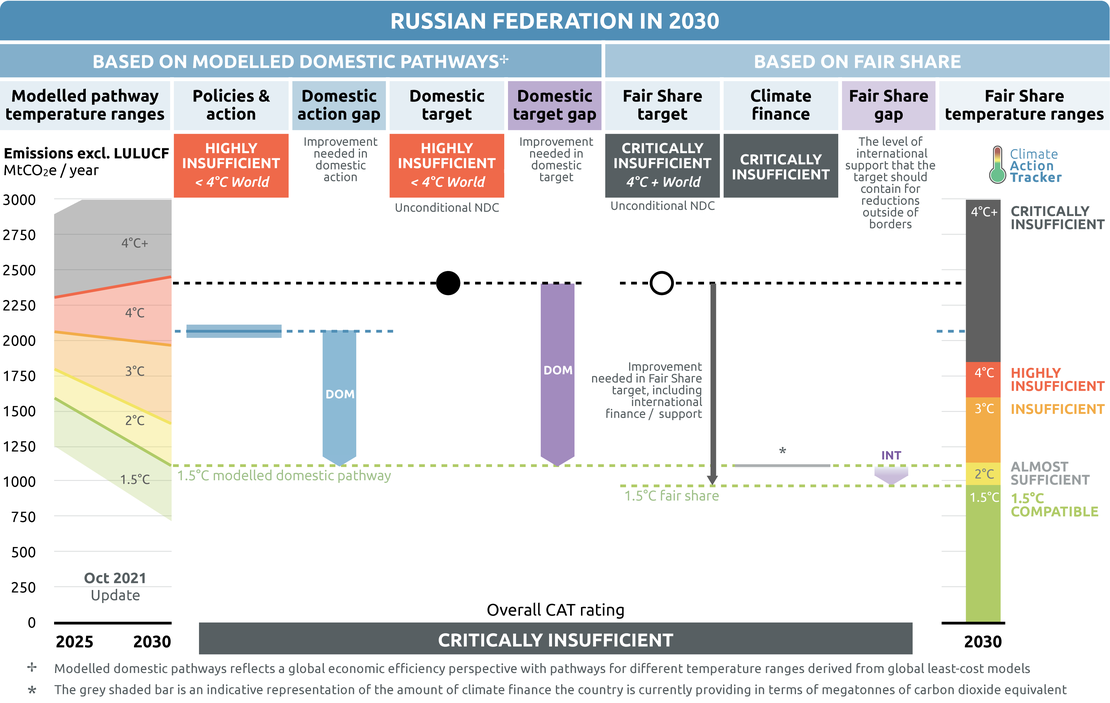Targets
Paris Agreement targets
NDC description
Russia formally submitted a new 2030 emissions target to the UNFCCC in November 2020. The update did not strengthen the country’s 2030 target in any real sense, as it is higher than Russia’s own 2030 emissions projections under current policies.
Russia’s updated 2030 target of a 30% reduction below 1990 levels, which replaces its previous target of 25-30%, amounts to a 2030 emissions level of 2.4 GtCO2e, which is equivalent to 24% below 1990 levels, excluding LULUCF, according to CAT estimates. Given the latest emissions projections under current policies provided by the Russian Government show 2030 emissions at 2.3 GtCO2e (excluding LULUCF), this does not represent an actual cut to emissions.
The CAT rates Russia's target as "Highly insufficient" when rated against modelled domestic pathways ("domestic target"), and "Critically insufficient" when rated against its fair share contribution ("fair share target"). Russia has not specified an international element in its NDC, so we rate the target against the two rating frameworks.
The CAT rates Russia’s updated 2030 emissions target; at least a 30% reduction below 1990 levels (incl. LULUCF), as “Highly insufficient” when compared with modelled domestic emissions pathways. The “Highly insufficient” rating indicates that Russia’s domestic target in 2030 leads to rising, rather than falling, emissions and is not at all consistent with the Paris Agreement’s 1.5°C temperature limit. If all countries were to follow Russia’s approach, warming could reach over 3°C and up to 4°C.
We rate Russia’s updated 2030 emissions target as “Critically insufficient” when compared with its fair-share emissions allocation. The “Critically insufficient” rating indicates that Russia’s target, compared to what its fair share would be in 2030, reflects minimal to no action and is not at all consistent with the Paris Agreement’s 1.5°C temperature limit. Russia’s target is not in line with any interpretation of a fair approach to meeting the Paris Agreement’s 1.5°C limit. Substantial improvements are needed. Some of these improvements should be made to the domestic emissions target itself, others could come in the form of additional support for emissions reductions achieved in developing countries in the form of finance. If all countries were to follow Russia’s approach, warming would exceed 4°C.
Russia’s international climate finance is rated as “Critically insufficient” (see below) and is not enough to improve Russia’s fair share rating.

Russia’s international public finance contributions are rated as “Critically insufficient”. Russia has not made any substantial contribution to international climate finance since the adoption of the Paris Agreement. To improve its rating, Russia needs to urgently both increase its financial contributions and stop funding fossil fuels abroad.
Russia has committed to provide a total of USD 10m in climate finance in 2020–2022 to the Green Climate Fund (Green Climate Fund, 2020). Even considering this recent commitment, contributions remain critically insufficient considering the size of Russia’s economy and its historical responsibility.
Russia actively finances fossil fuels abroad, including coal, such as in the Long Phu 1 Coal Plant in Vietnam (Global Energy Monitor).
Further information on how the CAT rates countries (against modelled domestic pathways and fair share) can be found here.
Last NDC update
Russia has updated its NDC, but did not increase ambition.
Russia’s new NDC is stronger on paper, but does not alter the real-world trajectory of its emissions. Russia’s own emissions estimates show current policy emissions projections in 2030 below its new target. Maintaining the same level of real-world emissions in 2030 goes against the Paris Agreement’s requirement that each successive NDC should represent a progression beyond the current one.

Net zero and other long-term target(s)
In the lead up to the COP26 UN climate negotiations in Glasgow, Russia announced it would set a 2060 net zero target. This was followed by government approval of the ‘Strategy of socio-economic development of the Russian Federation with low greenhouse gas emissions by 2050’ which formalised this target and included a target of reaching an 80% reduction in GHG emissions below 1990 levels by 2050 under its ‘intensive’ scenario (Russian Federation, 2021a).
This ‘intensive’ scenario projects a more than doubling of negative emissions achieved through the land use, land use change and forestry sector between 2030 and 2050 from 539 MtCO2e to 1,200 MtCO2e, meaning that steep reductions in emissions from the combustion of fossil fuels would not be necessary to achieve net zero emissions. The steep increase in negative emissions raises questions as to the viability of Russia’s planned approach to reach net zero emissions given emissions from fossil fuel combustion are projected to remain high until 2050.
2020 pledges
Under the Copenhagen Accord, the Russian Federation pledged to limit emissions by 15–25% below 1990 levels by 2020 (Russian Federation, 2010). In a subsequent 2013 Presidential Decree, Russia’s 2020 target was specified as a 25% reduction below 1990 levels excluding LULUCF emissions, equating to an emissions level of 2.4 GtCO2e (Russian Federation, 2014a).
Further analysis
Latest publications
Stay informed
Subscribe to our newsletter







